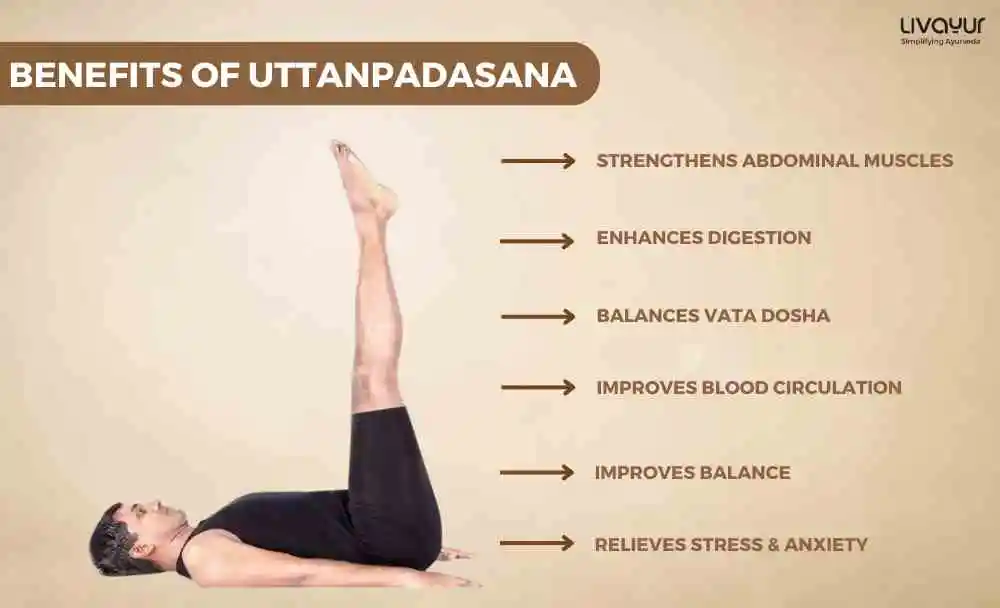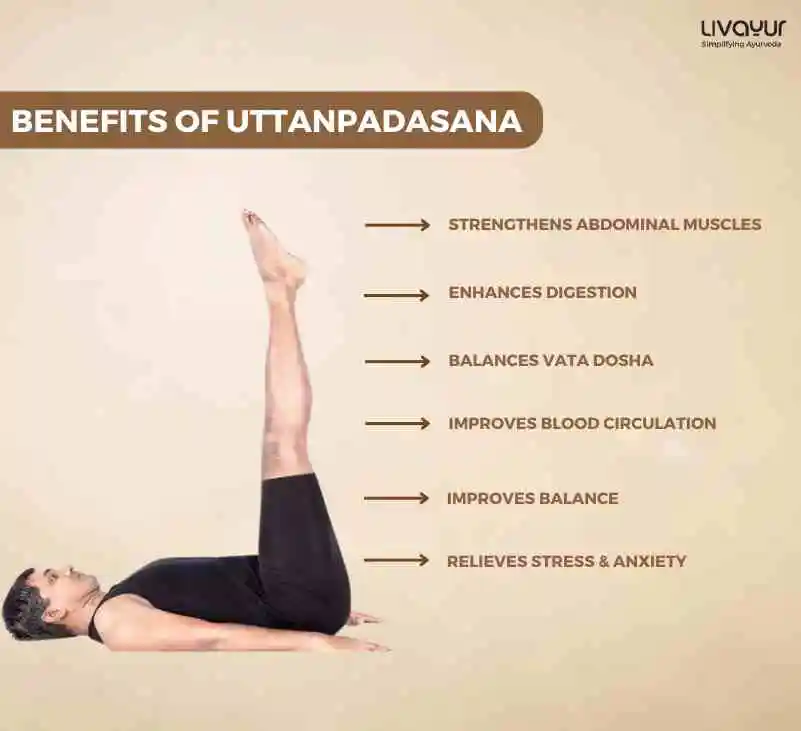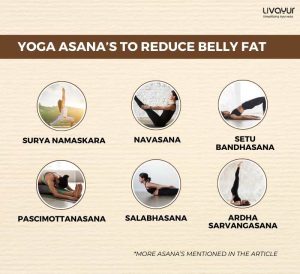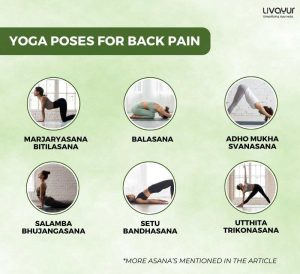This article is reviewed by an expert

Uttanpadasana, also known as the Raised Leg Pose, is a popular yoga asana that offers numerous physical and mental benefits. This asana involves raising the legs while lying on the back, which helps strengthen the core, tones the abdominal muscles, and improves overall body flexibility. In this article, we will explore the benefits of Uttanpadasana in detail, including its primary and secondary benefits, along with a step-by-step guide on how to perform the pose correctly.
Benefits of Uttanpadasana
- Strengthening the Abdominal Muscles
Primary Benefit: Uttanpadasana primarily targets the abdominal muscles, including the rectus abdominis and obliques. Regular practice of this asana helps strengthen and tone these muscles, leading to improved core stability and a flatter abdomen [1].
Secondary Benefit: Strong abdominal muscles provide better support to the lower back, improving posture and reducing the risk of lower back pain.
- Improving Digestion and Metabolism
Primary Benefit: Uttanpadasana stimulates the digestive organs, including the stomach, liver, and intestines, enhancing digestion and metabolism. It can help alleviate digestive issues like constipation and indigestion [1].
Secondary Benefit: A well-functioning digestive system promotes nutrient absorption, detoxification, and overall gut health, supporting overall well-being.
- Toning the Leg Muscles
Primary Benefit: This pose targets the muscles of the legs, including the quadriceps, hamstrings, and calf muscles. It helps strengthen and tone these muscles, leading to improved leg strength and stability.
Secondary Benefit: Strong leg muscles support proper posture, balance, and mobility, reducing the risk of injuries and promoting overall functional fitness.
- Enhancing Blood Circulation
Primary Benefit: Uttanpadasana improves blood circulation in the lower body and protects against hypertension [2]. The inverted position created by raising the legs helps increase blood flow to these areas, bringing fresh oxygen and nutrients to the cells.
Secondary Benefit: Improved blood circulation supports cardiovascular health, reduces swelling in the legs, and can help alleviate symptoms of conditions like varicose veins [3].
- Relieving Stress and Anxiety
Primary Benefit: Practicing Uttanpadasana helps calm the mind and relax the body, reducing stress and anxiety [4]. The focused breathing and concentration involved in this asana promote a sense of mental clarity and tranquillity.
Secondary Benefit: Regular practice of this pose can improve overall mental well-being, enhance mood, and promote better sleep.
Step-by-Step Guide to Uttanpadasana
- Lie flat on your back with your legs together and arms alongside your body.
- Place your palms facing downwards, keeping them close to your body.
- Take a deep breath in and gently lift both legs off the ground, keeping them straight and together.
- Slowly raise your legs to a 45-degree angle or as high as you comfortably can.
- Keep your toes pointed and engage your abdominal muscles to support your lower back.
- Hold the pose for a few breaths, keeping your gaze fixed on your toes or towards the ceiling.
- Exhale and slowly lower your legs back down to the starting position.
- Repeat the pose for 5-10 rounds, gradually increasing the duration as you progress.
Precautions and Tips
- Avoid practising Uttanpadasana if you have a recent or chronic injury to the lower back, neck, or legs.
- If you experience any discomfort or pain during the pose, gently lower your legs and modify the posture to a level that feels comfortable.
- Always listen to your body and do not overexert yourself. Start with shorter holds and gradually increase the duration as you build strength and flexibility.
Conclusion
Uttanpadasana, the Raised Leg Pose, offers a wide range of benefits for the body and mind. From strengthening the abdominal muscles to improving digestion, enhancing blood circulation, and relieving stress, this asana can be a valuable addition to your yoga practice. Remember to approach Uttanpadasana with patience and awareness, honouring your body’s limitations and gradually progressing at your own pace. Enjoy the practice and experience the transformative effects of this powerful yoga pose.
Frequently Asked Questions (FAQs)
- Can Uttanpadasana help reduce belly fat?
While Uttanpadasana strengthens the abdominal muscles, it is important to note that spot reduction of fat is not possible through any exercise or yoga pose. Regular practice of Uttanpadasana, along with a balanced diet and overall fitness routine, can contribute to overall weight management and toning of the abdominal muscles.
- Can Uttanpadasana be practised by beginners?
Yes, beginners can practice Uttanpadasana with modifications. Start by lifting the legs to a comfortable height and gradually increase the intensity as you build strength and flexibility. It is recommended to learn this pose under the guidance of a qualified yoga instructor to ensure proper alignment and technique.
- Can Uttanpadasana help with menstrual discomfort?
Uttanpadasana may help alleviate mild menstrual discomfort by promoting blood circulation in the pelvic region. However, it is important to listen to your body and avoid any poses that cause discomfort during menstruation. Consult with a healthcare professional or a qualified yoga instructor for personalized guidance.
- Is Uttanpadasana suitable for individuals with back pain?
Uttanpadasana can be beneficial for individuals with mild to moderate back pain, as it helps strengthen the core muscles and provides support to the lower back. However, if you have a history of severe back pain or any spinal conditions, it is advisable to consult with a healthcare professional or a qualified yoga instructor before attempting this pose.
- Can Uttanpadasana be practised during pregnancy?
It is advisable to avoid practising Uttanpadasana during pregnancy, particularly during the second and third trimesters. It’s always best to consult with a healthcare provider or a qualified prenatal yoga instructor for modified poses that are safe and suitable for pregnancy.
Disclaimer: The information provided here is for general information and not meant to substitute any medical advice. Please consult your doctor for appropriate medical consultation.
References:
- https://www.ijrap.net/admin/php/uploads/1176_pdf.pdf
- https://www.ncbi.nlm.nih.gov/pmc/articles/PMC8452415/
- https://rjptonline.org/HTMLPaper.aspx?Journal=Research%20Journal%20of%20Pharmacy%20and%20Technology;PID=2022-15-7-28
- https://www.researchgate.net/publication/319176251_Psychophysiology_of_Yoga_Postures_Ancient_and_Modern_Perspectives_of_Asanas






















